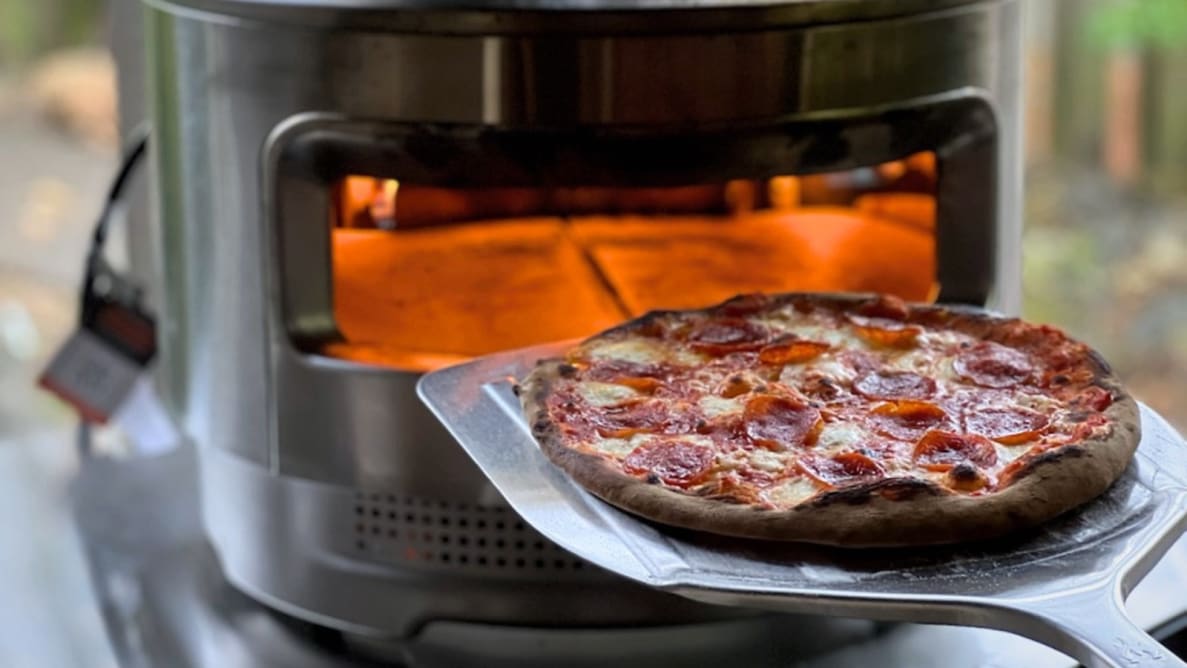Pros
-
Heats exceptionally quickly
-
Cooks pizza evenly
-
Multiple fuel sources
-
Lightweight
Cons
-
Small gap in pizza stone
-
Temperature regulation with wood takes practice
Editor's Note: The Dual-fuel and Wood-only versions of the Solo Stove Pi are only available from Solo Stove. For a gas-only option, read our review of the Solo Pi Prime, which is also available at other retailers.
About the Solo Stove Pi
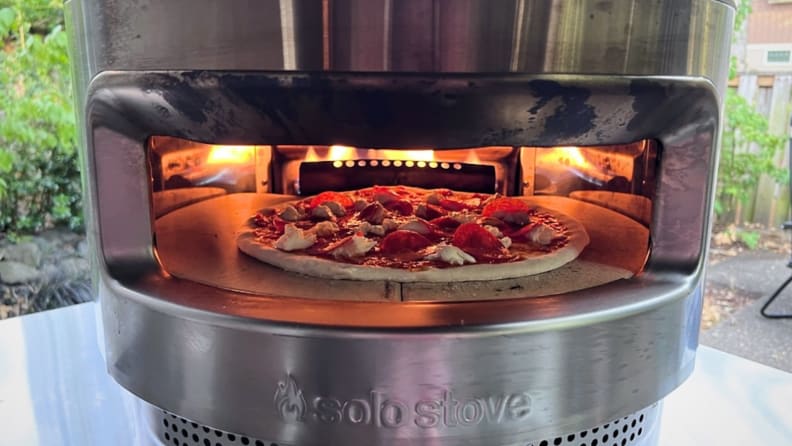
The Solo Stove Pi has a slightly larger opening than other pizza ovens we've reviewed, making it easier to maneuver cooking pizzas.
- Dimensions: 15.125 in. high x 20.5 in. diameter (38.42 cm high x 52.07 cm diameter)
- Cooking surface: 12 in. x 12 in.
- Weight: 30.5 lbs (13.83 kg)
- Materials: Stainless steel
- Features: Multi-fuel option, cooking area for 12-inch pizzas; additional accessories and cover available for purchase separately
- Fuel Type: Multi Fuel: Wood and propane gas burner sold separately
- How hot it gets: Wood burning: stone 750°F, ambient air 850°F; Gas burner: stone 800°F, ambient air 900°F. Please note that outside ambient conditions can affect stone and air temperatures. The temperatures of the wood burning setup can vary depending on the type of wood and the frequency and quantity of fuel added.
Solo Stove Pi purchasing options: Wood only or wood and gas
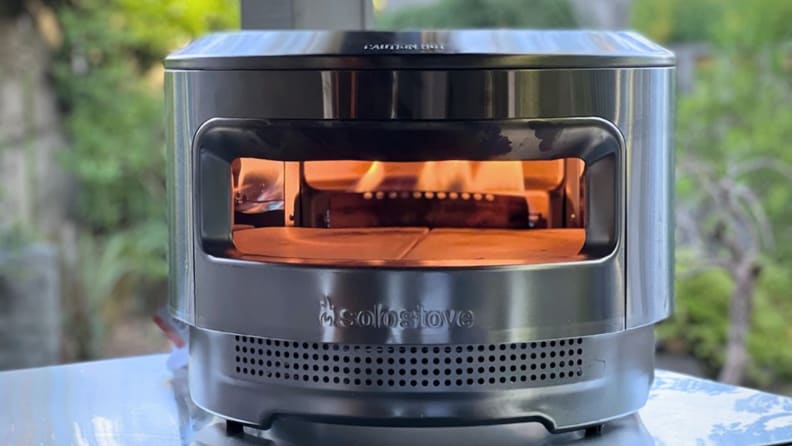
The wood-fired version takes some practice to get just right, but the flavor is worth it.
There are two options for purchasing the Solo Stove Pi pizza oven. The first is Wood Only, which includes a wood burning assembly with an 11-inch fuel grate and ash tray. You will need to use small wood chunks (1 in. wide x 5 in. long) to operate the pizza oven.
The second option is Wood & Gas and provides a choice of using the wood burning assembly or removing it and screwing a propane burner attachment into the back of the unit. We recommend this option for beginners or casual pizza cookers. It’s much quicker to start the oven with propane, and there’s very little learning curve compared to cooking with wood. Buy the Wood Only Pi
Bundle options
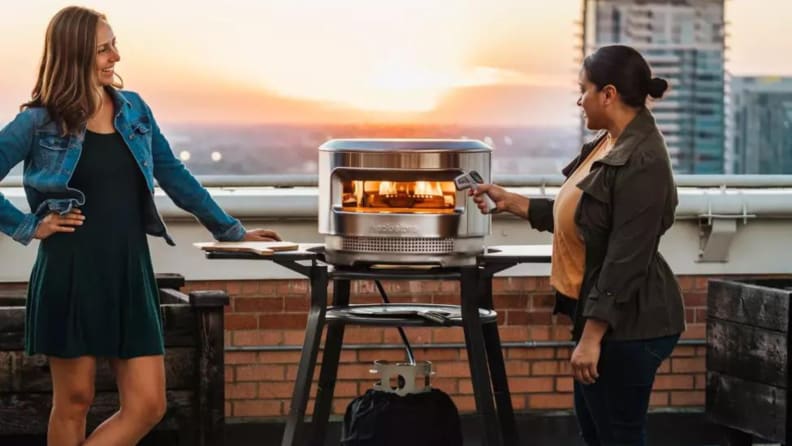
Solo offers several bundle options, including one with a stand, so you can get a setup that works for you.
Solo Stove offers several bundle options, available in Wood Only or Wood & Gas. The Pi Starter Bundle includes a stainless steel pizza peel and a pizza cutter, and an infrared thermometer for measuring the stone’s temperature (when they come back in stock later this year). The Pi Essentials Bundle includes everything in the starter bundle along with a cover for the pizza oven and a stainless turner to turn and rotate pizzas as they bake.
Solo Stove also offers the Pi Ultimate Bundle, which comes with a bamboo pizza peel that doubles as an attractive serving piece. If you don’t have a table in mind for your new pizza oven, this bundle is a great option because it also includes a stand. The two shelves on each side are convenient for storing cooking tools and building pizzas, and 360-degree rotating caster wheels make it easy to store the oven when not in use.
The best part? The Pi oven nests into the stand instead of locking in place, so you can still take it on the go if you want to bring the pizza party with you.
- Pi Stand Dimensions: 38.1 in. high x 47.3 in. long x 35 in. wide (96.77 cm high x 120.14 cm long x 88.9 cm wide)
- Pi Stand Weight: 45 lbs (20.41 kg)
- Pi Stand Materials: Powder-coated steel
- Pi Stand Features: 360° rotating caster wheels with locks; propane tank storage shelf; two side shelves and one underneath shelf for tool and accessory storage.
How the Solo Stove Pi works
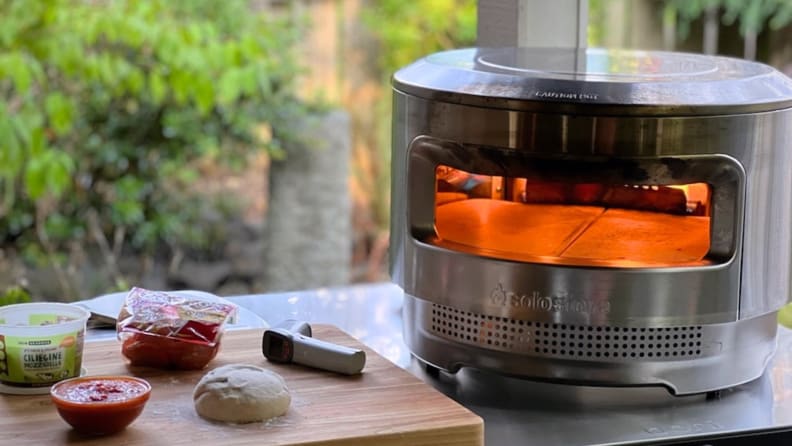
Beginners and veterans alike will find the Solo Stove Pi easy to set up and use.
The Solo Stove Pi has the same look as the brand's fire pits and grill, with a sleek, stainless steel exterior and perforated holes lining the bottom. The unit comes pre-built, and all you need to do is place the two-piece cordierite pizza stone inside the unit.
From there, you have two options. If you purchased the wood only unit, you’ll place the wood burning assembly inside the oven. There are easy-to-follow instructions for lighting a fire in the owner's manual or on Solo Stove’s blog, but it will take some time and practice to perfect your method. The amount of fuel you add, the type of wood used, and the timing of the wood additions will affect the temperature inside the oven.
The gas option, on the other hand, is super simple to use. Screw in the gas burner attachment, connect the hose to a propane tank, and ignite the burner by turning the knob until you hear a loud click. You can leave the dial on high to heat the pizza oven as high as possible (the highest we reached during our tests was 780°F for making Neapolitan pizzas).
There are a series of white and orange dots on the dial as you reduce it from high to low, which we found helpful for finding the right setting to heat the stone to 500°F for New York-style pizzas.
What we like
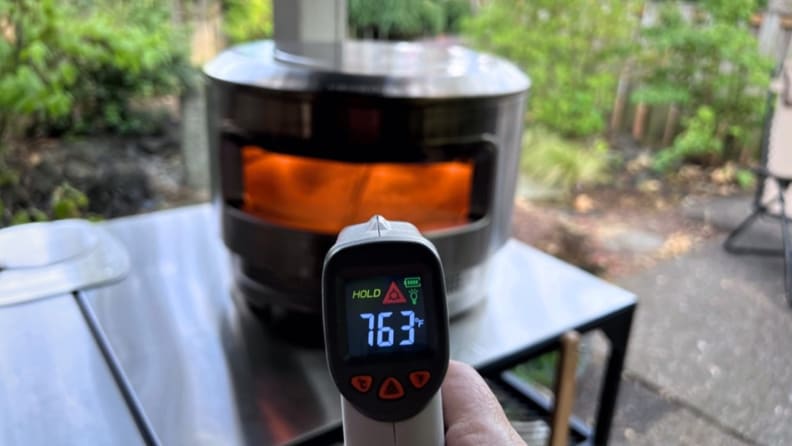
The Solo Stove Pi heated up a full 10 minutes faster than other pizza ovens we've tested.
The pizza stone heats up quickly and maintains heat exceptionally well
When using the propane attachment on its highest setting, the pizza stone reached 650°F within 10 minutes and hit 780°F at the 20 minute mark. That’s pretty fast, considering that most of the pizza ovens we’ve tested before take around 30 minutes.
We were also impressed at how quickly the stone recovered after making the first pizza. The stone heats up as the oven preheats, but it naturally cools down as soon as you load the first pizza. Since the stone is responsible for cooking the bottom of the pizza, the second pizza will lack color and cooked texture if the oven doesn’t recover quickly.
With some pizza ovens, you have to wait as long as five minutes for the stone to heat back up. We didn’t experience this problem with the Pi, though. It was ready to load a second pizza within two minutes of removing the first, so we can definitely recommend this oven for anyone who wants to throw a backyard pizza party!
The design promotes hot airflow on top of the pizza

The results of our testing put this Solo Stove pizza oven at the top of our list.
We were really impressed at how the airflow inside this pizza oven worked like a convection oven, moving hot air over the top of the pizza as it cooked. This feature shouldn’t be much of a surprise if you’ve used Solo Stove products before. The airflow design is one of the reasons these fire pits are mostly smokeless, and it’s why the portable grill heats so evenly.
Solo Stove explains that the design is called “Demi-Dome Construction,” and it creates convection airflow that distributes heat to the entire oven. Cold air is brought in through the holes at the bottom of the oven, and it’s heated as it passes through the flames. The heated air then flows over the top of the pizza, so the pizza cooks simultaneously from the bottom and the top when it’s in the oven.
We not only observed this convection airflow at work when we cooked pizza—creating an evenly cooked pie without a burnt bottom or charred toppings. We also noticed it when cooking steak and broccoli in a cast-iron pan inside the pizza oven. The top of the steak seared just as well as the side that was in contact with the preheated pan.
It can be used with multiple fuel sources
Who doesn’t love choices? Purchasing the Wood & Gas Pi allows you to decide whether you want to go the classic wood-fire pizza route or the quick-and-easy weeknight pizza route. If you’re a beginner, we recommend starting with the propane burner until you get the hang of making pizza dough, building your pizza, and cooking it inside a super-hot oven.
Those who are a little more experienced will have a ton of fun learning how to build a right-sized fire inside the oven, and cooking over fire is a fantastic way to up your pizza-making game.
It’s lightweight and easy to store
The Solo Stove Pi is much lighter than many of the pizza ovens we tested. It’s half the weight of the Ooni Karu’s 62.6 pounds, and it’s 15 pounds lighter than the Gozney Roccbox. That makes it possible to transport the Pi to your friend's backyard barbecue, bring it camping, or pack it along to a beach party (although we’d be wary of all that sand).
We also appreciated the compact round design. The 21-inch diameter oven sits just 15 inches high, so you won’t have to buy a special table to accommodate the addition to your backyard setup. It’s low-profile enough to tuck nicely onto a shelf in the garage, too.
It boasts a panoramic opening
The opening on most pizza ovens is the same size as the pizza stone. That means there’s very little room for maneuvering, and you have to be spot-on when launching your pizza into the oven. A tricky task for those new at pizza making!
The Solo Stove pizza oven’s opening is 13 inches—one inch larger than the size of the pizza stone. That extra inch doesn’t sound like much, but it made a huge difference when it came to loading and turning the pizza when it was inside the oven.
It’s super easy to clean
To clean the Pi, fire it on high to burn off any accumulated cheese or dough. Then, let it cool completely and brush it out with a stiff-bristled brush or a damp cloth. If desired, the pizza stone can be removed for thorough cleaning, although it’s not necessary on a regular basis. To clean the exterior, simply wipe it down with a soapy cloth.
Solo offers a lifetime warranty
The Solo Stove Pi has a lifetime warranty to be free of manufacturing defects, and Solo Stove will replace any genuine Solo Stove product sold by an authorized retailer that is deemed defective. Products are not warrantied against normal wear or misuse, but the customer service team will help you analyze any misuse damage.
If it’s unable to be repaired, they will extend a one-time courtesy offer to purchase a new Solo Stove product for 50% off the MSRP prices listed on the website (excluding web specials).
Solo Stove also offers a 30-day guarantee for purchases made through Solo Stove authorized retailers. Any orders shipped within the contiguous U.S. (lower 48 states) can be returned within 30 days of when the order was shipped and they’ll process a full refund back to the original payment method.
A branded pizza kit of high-quality ingredients to help make your perfect pie

The Neapolitan Artisan Pizza Kit has everything you need to make delicious pizza in the Solo Pi.
An outdoor pizza oven makes it possible to make restaurant-quality pizza at home, but it’s not the only component to building a great pie. You’ll also need a solid dough recipe to create pizza with the right texture and consistency, and getting there can take a little practice.
If you’re not ready to start that journey, but you’re eager to dive into the world of pizza, take a shortcut and buy pre-made dough (just not the kind you find in a tube). We’ve tried dough from several stores—Trader Joe’s, Whole Foods, and Kroger, to name a few—so we were eager to try Solo Stove’s Pi Ingredients to see how it stacked up. You can purchase the dough via the Neapolitan Dough Balls package, which comes with 24, 9-ounce dough balls specifically designed to make 12-inch pizzas.
For those who don’t want to shop for additional ingredients, the Neapolitan Artisan Pizza Box reduces the dough count to 12, but it also comes with everything you need to make those pizzas: San Marzano pizza sauce; fresh mozzarella; and a 24-ounce Ezzo's Pepperoni Stick that’s almost two feet long.
We were pretty impressed with the high-quality nature of these ingredients, and all in all, these kits are a great way to take the guesswork out of making pizza. They come shipped frozen and can be thawed overnight to be ready for a pizza party within 24 hours.
We wish the dough came individually packaged so it was easier to freeze, but it was simple enough to wrap each ball in plastic wrap before tossing it into the freezer. As with all dough (store-bought or homemade), it’s important to let the dough ball sit on the counter for at least 30 minutes (or up to two hours) before baking for easy stretching.
Compared to other grocery store dough, the Solo Stove dough was easy to work with and didn’t exhibit any signs of resistance or tearing. When it hit the hot pizza oven, it had a great rise, cooked perfectly, and had a slightly sweet flavor.
The San Marzano sauce is rich with a nice acidity, and it doesn't have the concentrated, sweet taste that comes from using tomato paste (one of our biggest complaints about store-bought sauce). The mozzarella is also rich and creamy, and it melts exceptionally well. The pepperoni was a little difficult to slice, so you’ll need to reach for your sharpest knife. But we enjoyed the spicy, salty quality that came from that as well.
What we don’t like
There’s a small gap in the pizza stone
The stone for the Solo Stove Pi breaks apart into two pieces. This is helpful for removing the stone when you want to clean it, but it leaves a small gap when both pieces are placed inside the oven. Really, this isn’t a big deal—it didn’t seem to affect the cooking of the pizza—but it did set off our OCD alarm every time we looked at it.
Regulating the temperature with wood takes practice
Solo Stove knows all about burning wood, so it was no surprise that the Pi excelled at making wood-fired pizzas. That said, it really takes some time and practice to get it right, and there’s a steep learning curve.
The wood burning assembly tray is very small—11 inches long— so you have to cut your wood down to 1-inch wide by 5-inches long to get it to fit. If you place a couple of starter cubes in with the wood, the pile will catch very quickly and begin to heat up the oven. But if you put too much wood in, the fire will smolder and smoke instead of build heat.
You also need to be careful not to burn too much wood. If the ash pan fills up, the fire will go out and you’ll need to empty it out before continuing. Considering everything inside the oven is so hot, that’s not as easy as it sounds! If you’re planning to cook more than five pizzas in one setting, gas is definitely the way to go.
The screws for the propane burner can be easily lost
If you’re the type of person who loses things, and you plan to switch between gas and wood fuels, you’ll want to be very, very careful when storing the propane attachment. The two screws that attach the propane burner to the back of the Solo Stove can’t be easily replaced with something purchased at the hardware store. There’s a spot to store them on the bottom of the Solo Stove, so make sure you put them back there every time you remove the attachment so you don’t misplace them.
Should you buy the Solo Stove Pi?
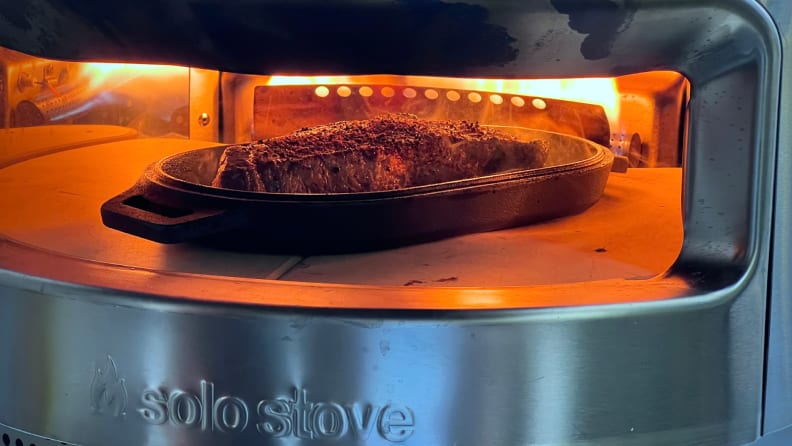
Steak cooked beautifully in a cast iron skillet in the Pi, making a multi-use outdoor cooking appliance.
Yes, if you have any interest in cooking pizza on a regular basis.
Bottom line, the Solo Stove Pi is a joy to use. The propane burner is convenient when firing up the oven for one or two pizzas on a weeknight, and the option to use the oven as a wood-burning stove is fantastic for anyone who wants to delve deeper into craft pizza.
The Solo Stove Pi is a little bit more expensive than some of the Ooni options, but we were impressed with how easy it was to use for beginners and veterans alike. It’s hard to say how long the ovens last—they just launched in 2022—but they’re made with the same high-quality materials as the fire pits, so we have no reason to believe they won’t last for years.
Buy the Wood & Gas Pi for $615
Meet the tester
Lindsay is a professional chef, recipe developer, writer, and developmental editor. After years of working in restaurant kitchens, she turned to writing to share her passion for local, organic, and seasonal ingredients with home cooks and food enthusiasts.
Checking our work.
Our team is here to help you buy the best stuff and love what you own. Our writers, editors, and experts obsess over the products we cover to make sure you're confident and satisfied. Have a different opinion about something we recommend? Email us and we'll compare notes.
Shoot us an email

